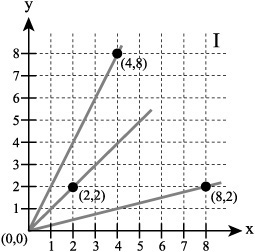Points, Intercepts, and Slopes
Figure 6.9 illustrates the rise and run of a line you generate with a linear equation. To identify the slope, consider first that you can identify a line using two points.
Figure 6.9. You use two sets of coordinates to identify a slope.

In Figure 6.9, you create three lines using unique sets of coordinates. Each line starts at the origin of the Cartesian plane. For the middle line, the coordinate set is as follows:
(0, 0) (2, 2)
Given this set of coordinates, you can then determine the slope of the line if you establish the ratio of the rise (y) to the run (x). Here is the equation and work that accomplishes this task:
![]()
The slope, then, is 1.
For the upper line, you start with this set of coordinates:
(0, 0) (4, 8)
As with the middle line, you determine the slope of the upper line if you establish the ratio of the rise (y) to the run (x):
![]()
The slope is 2.
For the bottom line, you follow the same approach as before. Your starting coordinates are these:
(0, 0) (8, 2)
As with the middle and lower lines, you can determine the slope of the line if you establish the ratio of the rise to the run:
![]()
For each unit the line rises, it runs 4 units. The slope is ![]()
Using the slope-intercept equation, you can shift the line you generate for a linear equation above or below the x axis by using a constant to designate the y-intercept:
y = mx + b
The letter b designates the y-intercept. A line by definition connects two points. To establish one of these two points, as Figure 6.9 reveals, you can use the coordinate values of the origin. On the other hand, if the line does not pass through the origin, you can work with the coordinates that define the y-intercept.
In both instances, after you calculate the slope of the line, you can use the slope to calculate other coordinates.
When you work with the y-intercept, the first coordinate that defines the intercept is 0, which establishes the value of the run (x). The second coordinate establishes the value of the y-intercept. Here is a representative equation containing a y-intercept:
y = 2x + 3
Given this equation, you know that the line generated includes one coordinate pair in which x equals 0 and y equals 3.
As Figure 6.10 illustrates, using the y-intercept as a starting point, you can use the slope information to determine new points. The slope is 2. If you move to the right by 1 unit along the x axis, you know that you move upward by 2 units on the y axis. If you start at the y-intercept, you can then arrive at a coordinate of (1, 5). Here is how you calculate this value using the slope-intercept equation:
Figure 6.10. The slope and y-intercept allow you to generate points on the line.

y = 2x + 3
y = 2(1) + 3
y = 2 + 3
y = 5
